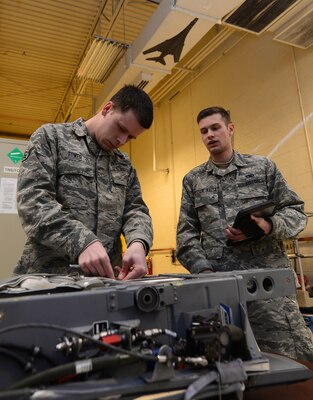By Air Force Airman 1st Class Donald Knechtel 28th Bomb Wing
ELLSWORTH AIR FORCE BASE, S.D., March 14, 2018 — The
Advanced Concept Ejection Seat, or ACES II, is a system designed to save an
aircrew at a moment’s notice. Otherwise known as the “last chance for life,”
the seat is the last hope an aircrew has when it comes to surviving an
unexpected failure. When the time comes, they must have complete faith in the
system and the well-trained group of airmen who maintain it.
“It’s all about preventative maintenance,” said Air Force
Tech. Sgt. Keith Percy, an egress systems craftsman with the 28th Maintenance
Squadron here. “We have to be on top of it because we can’t test the system.
Everything that we do has to be perfect -- everything.”
The team of airmen ensure this during an egress final
inspection, which is required every 30 days. During the inspection, the
technicians perform a full diagnostic of the system, check for any broken
components and swap out expired time-changeable items to ensure the aircraft is
good to go.
“On each seat, we have a number of time-changeable items
that will expire if not swapped out, such as explosives, bad actuators, load
resters, survival kits, etc.,” said Tech. Sgt. Mathew Wagner, an egress systems
craftsman with the 28th Maintenance Squadron.
When multiplied by a fleet of approximately 25 B-1Lancer
bomber aircraft, the workload gets pretty large. Aside from the explosive lines
throughout the cockpit, the team of airmen must inspect for any and all things
that could cause a system failure, such as frayed parachutes, old or
nonresponsive equipment and corrosion. Then, after replacing the defective
equipment, the airmen need to ensure the ejection equipment is properly seated
into the aircraft.
Wagner said egress is a massively important part of an
aircraft’s operability. With no room for error, the team must be on their toes
and hyperaware of their repairs at all times.
“We can't afford to make mistakes,” he said. “I’m not saying
our maintenance is more important than everyone else’s, but where they can test
their systems to ensure they did it correctly, we cannot.”
Because the ACES II is a one-and-done mechanism, egress
technicians must put their heart and soul into maintaining it.
“I’ve experienced ejections in the past, and the first thing
that goes through your head -- the first thing you ask -- is, ‘Did they make it
through,” Percy said. “Job satisfaction comes from ensuring the pilots are safe
and we did our jobs well, but I could go my whole career without another
ejection happening.”
Although ejections are rarely seen, aircrews can rest easy
knowing the egress teams' skill and dedication help ensure their safe return
when met with a worst-case scenario.
“That’s why this section is always under the squadron’s
microscope,” Wagner stated. “We are the last system in the aircraft that needs
to work – the last line between life and death for the aircrew. It’s important
the seat works properly so these aviators can come home to their families and
fly another day.”

No comments:
Post a Comment